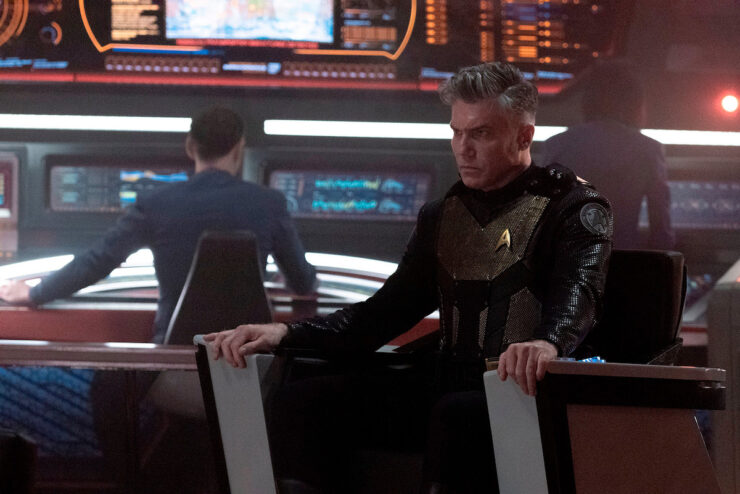Throughout its first season, Strange New Worlds gave us a number of different plot and character threads. We had some development of the Spock-T’Pring relationship, we had Pike dealing with his foreknowledge of his eventual fate as a disabled person, we had the threat of the Gorn, we had the revelation that Number One is genetically engineered and has been hiding it and we also had way too goddamn little of Number One, we had a potential recurring adversary in Captain Angel and the crew of the Serene Squall, as well as Spock’s half-brother Sybok, we had Uhura trying to figure out if she wants to continue with Starfleet, we had M’Benga trying to save his daughter, we had La’an dealing with the weight of her ancestry, we had Pike’s attempt at a relationship with Batel, and we had Chapel’s crush on Spock.
Only some of that got followed up on in a most uneven sophomore season.
First, let’s talk about what we didn’t see, which was any kind of followup to “The Serene Squall,” which is maddening, as that episode very obviously teased us for a sequel. I suppose it’s possible that Jesse James Keitel wasn’t available to return as Captain Angel. Still, this is the problem with having only a ten-episode season, there are limits as to how many different balls you can juggle.
Sadly, they do follow up on the Gorn. There are two problems here. One is that this version of the Gorn and the Federation having this much contact with them both seem to contradict the original series’ “Arena.” In particular, portraying the Gorn as force-of-nature monsters that indiscriminately kill everything in its path and use other living beings to gestate their eggs is at odds with the hopeful message of cooperation in “Arena” (not to mention the implication of future peace and harmony implied by Cestus III being established as a thriving Federation world in the twenty-fourth century in DS9’s “Family Business”). The biggest sin, though, is that the Gorn as reimagined by SNW are incredibly boring. I could possibly live with the contradiction with “Arena” if it was in service of a nifty set of stories, but instead we’ve gotten three action-adventure tales, only one of which was worth spending an hour watching (“Memento Mori” last season), and the other two of which are, in your humble reviewer’s opinion, the two worst SNW episodes to date (last season’s “All Those Who Wander” and this season’s finale “Hegemony”).
Thankfully, Pike’s future knowledge—which was pretty much played out by the time it was dealt with in “A Quality of Mercy” with its timeline-shifting shenanigans—is not a theme this season, only briefly mentioned in “Those Old Scientists,” when Pike is talking to two Starfleet officers from the future who also know his fate. (More on that Lower Decks crossover in a bit.) And Uhura has definitely settled in as a career Starfleet officer, now an ensign and kicking ass at the communications console (though her grief over Hemmer comes up a few times, most notably in “Lost in Translation”).
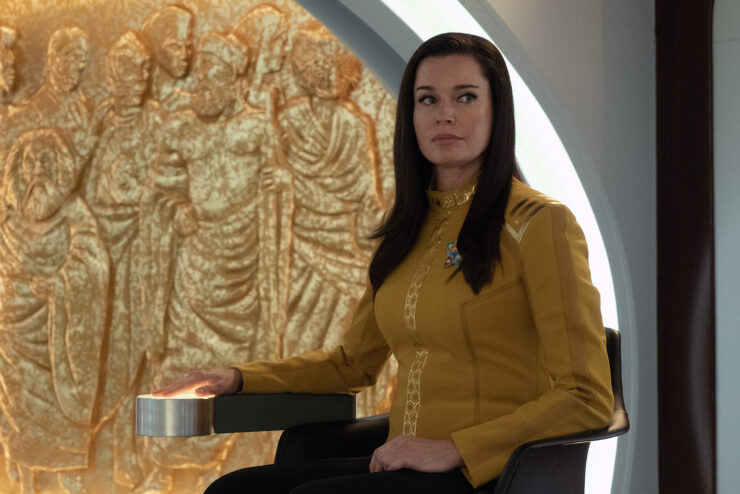
Number One’s arrest at the end of the first season is dealt with in the second episode, and while I still don’t think Rebecca Romijn is getting nearly enough screen time, she absolutely kills it in “Ad Astra per Aspera,” which beautifully chronicles her court-martial. After that, we see more of her actually acting as first officer (particularly effectively in “Lost in Translation” and “Under the Cloak of War”), which is welcome.
La’an’s development continues nicely, as she has a wacky time-travel adventure with an alternate-timeline version of Jim Kirk, falls in love with him, watches him die, and then realizes that a relationship with the mainline version of Kirk isn’t in the cards, as he’s involved with Carol Marcus at this point (a nice continuity hit with the Kirk-Marcus backstory established in The Wrath of Khan). But she isn’t discouraged, instead realizing that being open and friendly to people might be something she can try with someone who isn’t her mentor. (Number One is pretty much the only person she’s ever able to open up with.)
Ortegas doesn’t get much to do, though she gets a fun partial spotlight in “Among the Lotus Eaters” where she comes to appreciate her importance as the person who flies the ship. One thing this show and Discovery have both done is remember the importance of pilots, as the skills of Ortegas and Detmer are both nicely integrated into the storylines, something only Voyager got right previously with Paris. The original series’ Sulu and Enterprise’s Mayweather were always spoken of as great pilots, but those skills were rarely in evidence onscreen, the former due to the nature of supporting characters in 1960s television, the latter due to the writers never following up on what the series bible established about the character. Meanwhile, TNG had a rotating cast of pilots for most of its run, few of whom had the chance to make an impression before being promoted (La Forge), going to the Academy (Wes Crusher), or not being in enough episodes (Ro), while DS9 mostly had Dax be the default pilot on the rare occasions one was needed…
With the gratuitous and unnecessary and unsatisfying death of Hemmer last season, we get a new chief engineer in Carol Kane’s delightful Pelia, an immortal eccentric, who gets some of the season’s best scenes, interactions, and lines. And Pike and Batel’s relationship plays a more central role this season, with some delightful scenes between Anson Mount and Melanie Scrofano (and also between Mount and Romijn when Number One whups her captain upside the head when he’s being a doofus).
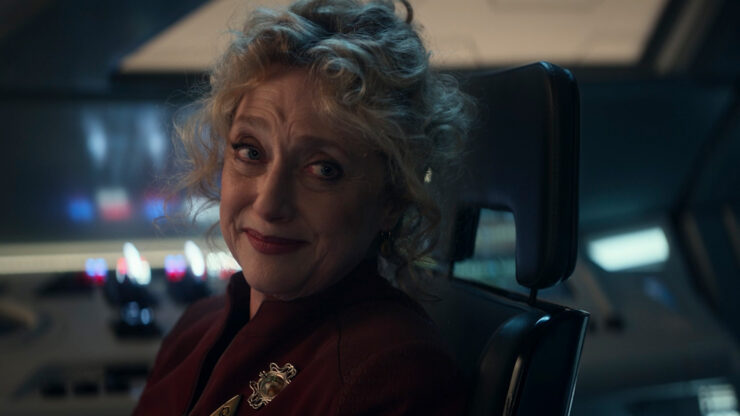
One of the best things about this season is that SNW truly embraces its status as a part of the greater Trek universe. This is a show that is, simultaneously, a spinoff of Discovery, a prequel to the original series, and the TV series that “The Cage” was a pilot for.
The first of those is seen in “The Broken Circle” and “Under the Cloak of War,” where we see the fallout from the Klingon war that occurred during Discovery’s first season. It’s established that Ortegas, Chapel, and M’Benga all served in that conflict, as well as possibly some other members of the crew, although the Enterprise in general and Pike, Number One, and Spock in particular we know from Discovery’s “Brother” did not participate in the war, kept in reserve.
M’Benga and Chapel, however, served in a field hospital on J’gal, the site of a brutal massacre. The PTSD they both share from that experience is first hinted at in “The Broken Circle” and then explicated in flashbacks in “Under the Cloak of War,” giving us one of Trek’s strongest meditations on the cost of war since DS9’s “The Siege of AR-558,” “In the Pale Moonlight,” and “It’s Only a Paper Moon.” That episode also shows where M’Benga first had the notion of storing someone in the transporter buffer (he did it for difficult patients who couldn’t get the treatment they needed immediately), a solution he used on his daughter, as well. We also find out that his background is with a special-ops team that he quit to go into medicine.
The show’s status as an original series prequel is embraced in numerous ways, mostly in terms of setting things up (and/or recontextualizing) for the show that started it all. There’s the obvious: the presence of Spock, Uhura, and Chapel in the main cast and Sam Kirk as a recurring regular, all of whose futures we know. We also get appearances by Jim Kirk in “Tomorrow and Tomorrow and Tomorrow,” “Lost in Translation,” and “Subspace Rhapsody,” all of which nicely presage his future as captain of the ship. My favorite is at the end of “Lost in Translation” when Uhura introduces Kirk to Spock, the episode itself establishing the beginnings of Kirk and Uhura’s friendship by the future captain helping out the ensign. I particularly love the casual-ness of it: just Uhura introducing her new friend to another colleague. It’s a very realistically prosaic beginning to a friendship that will be a cornerstone of the franchise.
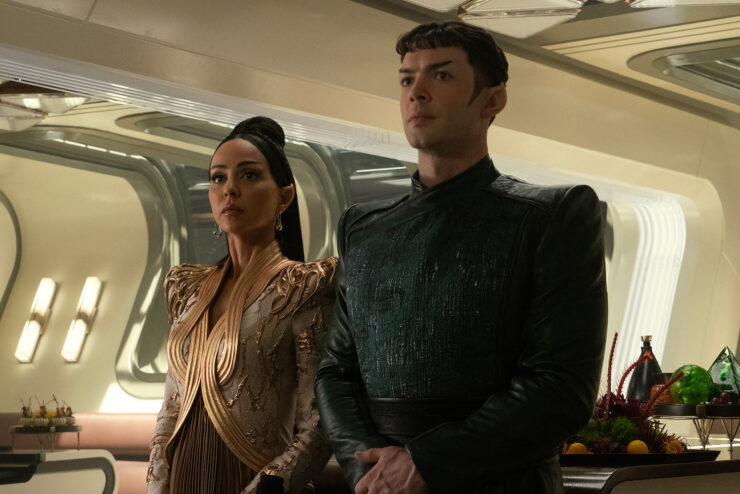
Speaking of Spock, his relationships with T’Pring and Chapel take major steps forward (or backward, depending on how you look at it). In T’Pring’s case, she back off from Spock when he proves unwilling to trust T’Pring with important information—to wit, that Spock had been made human by extradimensional aliens in “Charades.” Spock disguised himself to pretend to still be Vulcan for the sake of meeting T’Pring’s parents, but T’Pring herself should’ve been in on it.
After that, Spock decides to explore his humanity a bit, and also follow up on his own feelings for Chapel, which have only intensified over the course of the season—as has hers for him. But it proves a difficult road. Partly that’s because Spock being more human takes away a big part of what attracted Chapel to him. Partly that’s because Spock is unable to help Chapel through her own PTSD difficulties when a Klingon diplomat visits in “Under the Cloak of War.” And partly that’s because Boimler was so completely confused by Spock’s human experimentation in “Those Old Scientists,” meaning that someone who knew all about Spock’s entire life (which will extend for another century-and-a-quarter) saw that behavior as aberrant and not a major part of his life.
Spock and Chapel’s relationship seems to end in “Subspace Rhapsody,” the musical episode, which is an absolute delight. The best-written song in the bunch is Spock’s solo “I’m the X,” which has magnificent wordplay, with Spock saying both “I’m the ex,” as in ex-boyfriend, and “I’m the X,” meaning he’s the variable in the equation.
In general, Ethan Peck and the writers are doing magnificent work in showing a much younger Spock. Taking their cue from Spock’s big smile in “The Cage” (done, admittedly, because the notion of Vulcan suppression of emotions hadn’t been codified yet), the writers are doing a wonderful job of showing how Spock came to be the guy we all know and love in the original series and followup movies.
The same with Uhura, and the musical episode is one of two major turning points for the communications officer, the other being “Lost in Translation.” In both cases, the writers embrace Uhura’s role as the center of the ship’s community. Celia Rose Gooding is absolutely nailing the role, particularly in “Subspace Rhapsody,” where Uhura’s love of music—a long-established part of Uhura’s character from the beginning, making use of the late great Nichelle Nichols’ singing chops—is what catalyzes the plot and also saves the day. (Gooding is a phenomenal singer, too, though my favorite moment in the whole episode is her big smile as she bops along to the music with everyone singing.)
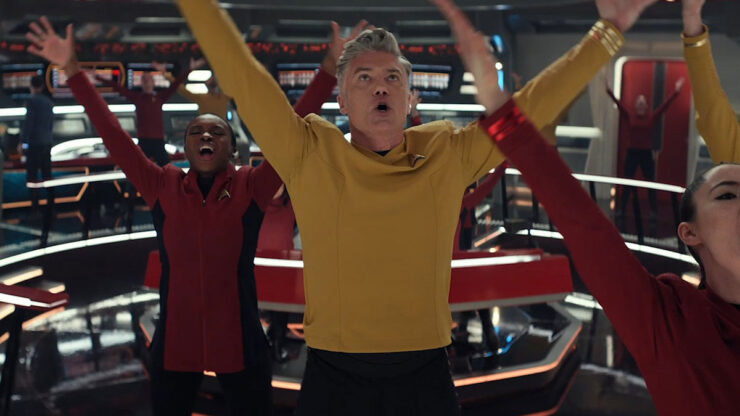
In addition, the episode “Among the Lotus Eaters” works nicely as a semi-sequel to “The Cage.” That first pilot for the original series had the Enterprise heading to base after a brutal mission to Rigel VII. “…Lotus Eaters” is a sequel to that mission—prior to 2019, it was the only other onscreen adventure of Pike’s Enterprise we knew about besides the mission to Talos IV.
On top of that, we get a full-on crossover between this show and LD thanks to time-travel shenanigans. It’s a near-perfect crossover, working as both an SNW episode and an LD episode.
For all that I’ve praised the season as a whole, there are issues. For starters, while it was apparently dictated by Mount needing some time off due to the birth of his child, Pike feels like a supporting character this season, which is only an issue insofar as Mount’s Pike is fabulous, and more of him is better than less of him. They establish in “The Broken Circle” that Pelia is friends with Amanda Grayson. But in Mia Kirshner’s one and only appearance this season as Amanda, “Charades,” Kane doesn’t appear as Pelia, which is a massively blown opportunity. Speaking of that, while “Charades” has important character stuff for Spock and Chapel, the episode itself is a sitcommy disaster.
It’s interesting, I’ve had mixed feelings about the season as I’ve been watching it, but looking back on it, despite the weaknesses, I have an overall positive feeling about it. While some episodes are better than others—from the peaks of “Ad Astra per Aspera,” which is a top-twenty Trek episode of all time, in my opinion, to the valleys of “Hegemony” and its tired action plot—what has remained consistent and strong is the development of the characters.
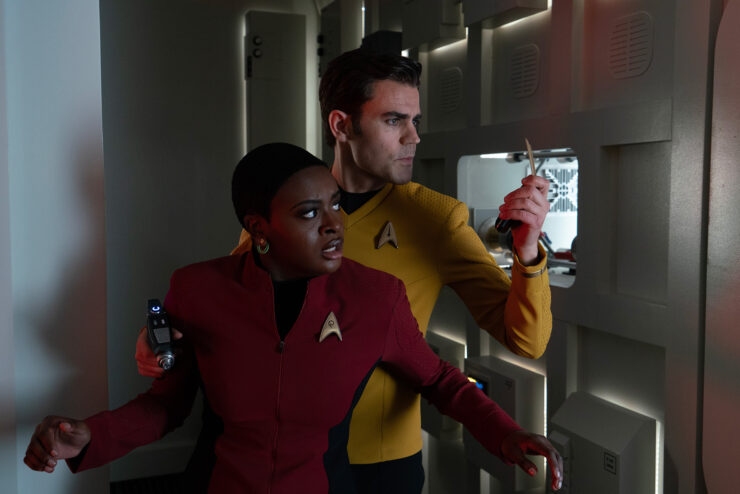
In fact, what we’re seeing is the solidifying of a family. Ortegas is the party animal who nonetheless can always be counted on to do what needs to be done when you ask her. La’an is the troubled loner who is shocked to find out that she has a support system who will help her. M’Benga is the tormented warrior who is trying to atone. Chapel is the brilliant polymath who is constantly searching for a new thing to learn (she applies for two different fellowships during this season, one of which she gets, with Dr. Roger Korby, whom we already know from the original series’ “What Are Little Girls Made Of?”) will become her fiancé) and has trouble maintaining connections. Uhura is the one always there to help, the glue holding the family together. Spock is the nerdy teenager who is still trying to figure out what kind of grown-up he’s going to be.
And at the top of it all are Captain Daddy and Auntie Una.
That generally positive feeling about season two is leavened by its ending, which is a less-than-compelling cliffhanger, compounded by the could-not-have-been-foreseen-when-they-wrote-it strikes by writers and actors that means it could be years, plural, before we see season three. In and of itself, that’s not an issue, as the strike is for very good reason, but the cliffhanger itself is weak sauce.
But whenever they do come back, they’ll be welcome. This is a family we need more of for damn sure. And maybe more episodes in a season so that we can spend more time with them?
Keith R.A. DeCandido urges you all to support the Kickstarter for Grandma Got Kidnapped by Aliens (and Other Holiday Disasters), edited by Hildy Silverman for Crazy 8 Press. This anthology of holidays gone horribly wrong will include stories by fellow Trek scribes Peter David, Michael Jan Friedman, Robert Greenberger, Paul Kupperberg, Glenn Hauman, Aaron Rosenberg, Geoffrey Thorne, Derek Tyler Attico, and Howard Weinstein. If the book makes a stretch goal, Keith will do a story as well! Please consider supporting.










